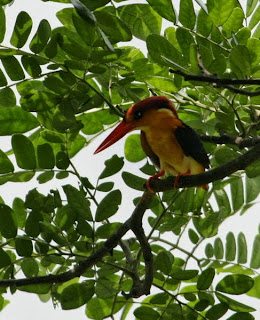Blue Banded Kingfisher
Finally my encounter with this local in Taman
Rimba Ampang after 8 visits to TRA. Luckily got some fellow birders to guide me
where to look. Actually it is always there. It's a question whether you have
the patience to sit there and wait. Of cause the dim condition do not help but
once sighted u can spend a good 15-30 minutes snapping away even with flash.
But try getting close to it will fly away.
There is suppose to be a male BBKF which have the blue band which the name is
coined. The female looks more colourful with its myriads of colors. Found in
clean fresh water streams hunting for fishes and insects. Not really tiny but
b'cos it has short tail it look small........ 4 inches from head to back.


Now these latest photos
confirmed my first sighting of BBKF ( almost 7.5 inches) in Kemensah about more
than a month ago . What we commonly see in Kemensah is the resident smaller
Blue-eared KF (6 inches). Madi coincidentially was also eyeing to see the BBKF
as I tagged along later distracted by bulbuls feasting on a fruiting ficus
trees at the carpark. Then a Greater Racquet-tailed Drongo was anting or
something on a tree trunk. Reaching Madi at about 9 am near a likely corner of
the stream Madi sighted it but was flushed out when he positioned his gears.
Whilst he kept vigilant for its return I move ahead to the other end to find
the Broadbill nest. And as bird luck was with me; the BBKF had perched on a
bamboo twig with a fish in its beak at the end of the open track. I quickly
snap some shots as insurance. I struggle to call Madi on the hphone but alas it
was gone in just a minute spooked by some local folks.
The Blue banded was once
the darling of Taman Rimba Ampang The last sighting there was about 3 years
ago. The photos here are of the Male BBKF. I managed a short video which I am
trying hard to post hopefully later..............so Kemensah is drawing a new
list of bird species and I hope to see more.............My suggestion birding
fellas is to go in 2 or on your own if you want to see it. Too many people will
just stress the bird okay and too many photog joistling for position will just
scoot it away.................bird luck to u.
Mission accomplished.
Madi your opportunity will come..........

















































